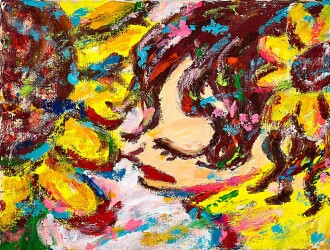
"The OTAKU, the passionate obsessive, the information age's embodiment of the connoisseur… is one of the keys to understanding the culture of the web. There is something profoundly post-national about it, extra-geographic. We are all curators, in the post-modern world, whether we want to be or not."
Sotheby’s Contemporary Showcase is a series of boutique online auctions that adopt a ‘pop-up shop’ concept with exciting thematic presentations. This edition will tap into our inner ‘otaku’ through our tightly curated assemblage of works. Otaku is a loaded word to describe the notoriously anime-obsessed fans who consume, collect and worship forms of popular visual culture. Its emergence as a major phenomenon in the 1980s had become the source of both widespread fascination and scorn. In the past three decades, however otaku culture has undergone an image overhaul. With the ascendance of geek culture, the obsessive pursuit has become a lifestyle to be celebrated not denigrated.
「『御宅族』,他們的狂熱近乎強迫症,是鑑賞家在資訊時代的化身……是了解網路文化的要素之一,深具後國族性及超越地域的意義。在後現代的世界裡,不管是否有意為之,我們都是自己的策展人。」
「御宅族」這個語帶偏頗的詞,指的是消費、收集、崇拜各種流行視覺文化,異常狂熱的動漫迷。「御宅族」的出現是1980年代的重要風潮,一方面從此掀起廣大社會的關注和興趣,同時亦引來上一代人的憂慮。但在過去的三十年間,「御宅」文化的形象已經改變。最近這十年間經歷過極客文化(geek culture)的興起,沉迷於某種愛好已不再遭人詆毀,反而是值得稱讚的生活方式。

"I believe otaku are a new breed born in the 20th century visual culture era. In other words, otaku are people with a viewpoint based on an extremely evolved sensitivity toward images."
Co-founder of the animation studio Gainax Toshio Okada describes the otaku as the quintessential collector. Through three modes of seeing: the eye for style (iki no me), the eye of the artisan (takumi no me), and the eye of the connoisseur (tsū no me), they are poised as highly advanced consumers and appreciators of culture.
Otaku themes find their origins in the unique historical context of post-war Japan, according to cultural critic Hiroki Azuma. However, he sees contemporary otaku culture as a phenomenon not necessarily unique to Japan, but forerunners of a postmodern mode of consumption. Otaku modes of expression are a response to generation-making events that shape our world.
Philip Colbert creates a surreal, utopian world in which his lobster alter ego pays tribute to the Tokyo Olympic Games as well as his predecessors, Andy Warhol and Jean-Michel Basquiat. In aCOVID-AI, graffiti artist Snipe1 explores a visual response as the pandemic casts its shadows over society. Much of the content reflects the otaku’s alienation from the mainstream culture or a conscious break from social cohesion. For example, Awol Erizku expands his Afrocentric aesthetic, by exploring the representation of the underrepresented.
「我認為御宅族是二十世紀視覺文化年代誕生的新族群。也就是說,這個族群對影像的觸覺極為敏銳,而他們的觀點是建立在這個基礎上。」
動畫製作公司「GAINAX」的創辦人之一,岡田斗司夫將御宅族形容為典型的收藏家。因為三種觀看方式:發現風格的眼光(「粋の目」)、精於技巧者的眼光(「匠の目」)、鑑賞者的眼光(「通の目」),御宅族被視為文化的高階消費者和欣賞者。
文化評論家東浩紀提出,御宅族議題源於戰後日本的獨特歷史背景。但他認為當代的御宅文化並非日本獨有的現象,而是一種後現代消費主義的前身。御宅族式的表達是對那些改變世界、塑造出不同世代的事件的回應。一如菲利普·考爾伯特將自己化身為龍蝦,並通過他創造的超現實烏托邦世界向東京奧運會,以及前人安迪.沃荷和尚.米榭.巴斯基亞致意。在作品《A.I COVID》中,塗鴉藝術家Snipe1探討了對疫情籠罩世界的視覺反響。二者主要表現了御宅族與主流文化的疏離,或是與社會凝聚力的刻意決裂,例如安沃·艾力克(Awol Erizku),將他以非洲文化為中心的美學,以藝術創作與圖像為少數群體、被忽略族群搭建呈現世人的無邊際舞台。

In an essay about Japanese culture, sci-fi novelist William Gibson wrote about a particular connoisseur with a ‘fascination with detail, with cataloguing, with distinguishing one thing from another.’ What they are looking are the ‘secret brands’, which the otaku undertakes to hunt ‘on specific, narrow-bandwidth, obsessional missions’.
Highlights include a KAWS’s package painting Untitled (Original Fake Series) which later lends its name to the artist’s brainchild with Medicom Toy, the celebrated streetwear and collectible label OriginalFake, Also presented in the selection of works are collaborations by Takashi Murakami, lead artist and founder of Kaikai Kiki Co. Ltd., with Virgil Abloh, founder of luxury label Off-White, conversing between two spectrums that shape modern and contemporary art, culture and lifestyle. Mark Newport’s Superhero knitting outfits also make their return, previously offered to the market from the prestigious collection of urban lifestyle pioneer as well as renowned art collector NIGO®.
在一篇關於日本文化的文章中,科幻小說家威廉.傑布森如此描述某位鑑賞家,「著迷於細節、分門別類、分辨不同事物」。這位御宅族答應尋找他們要找的「神秘品牌」,「肩負明確且範圍狹窄、強迫般的使命」。
本場最受矚目的拍品包括KAWS的「包裝畫」《無題》(Original Fake系列)。藝術家其後與MEDICOM TOY合作的結晶——深受歡迎的街頭服飾及收藏品廠牌Original Fake,就是由此系列而得名。精選作品還包括,Kaikai Kiki有限公司的創辦人兼領銜藝術家村上隆,與奢華品牌Off-White創辦人維吉爾·阿布洛(Virgil Abloh)攜手,締造現當代藝術文化生活不同界別對話的聯名創作。曾經由潮流教主兼著名藝術收藏家NIGO®釋出的知名藏品,馬克.紐波特(Mark Newport)的手工編織超級英雄服裝也將再度現身拍場。

The world of anime and manga is filled with bishōjo, beautiful girls usually depicted with innocent doe eyes and an alluring waif-like figure. She is a fictional dream girl that exists to inspire moe, an admixture of brotherly affection and attraction, which is a prominent part of otaku fantasy.
動畫漫畫中充斥著美少女形象——她們都有一雙大眼睛、天真無邪、身材纖瘦迷人,通常是即將成年的漂亮女孩。這個虛構的理想少女的存在意義在於激起「萌」感。這種兄長式憐愛之情和異性吸引力的混合,成爲御宅族幻想的主要構成。

In fantasy, there exists an unknown realm of yokai, kaiju, and kaidan, uncanny and supernatural beasts, many of which have their roots in Japanese folklore. Matías Sánchez’s heavily textured canvas features a grotesquely caricatured grinning figure, bizarre yet whimsically delightful. August Vilella’s doe-eyed spiritual creature roams in his stylised Grimm’s fairy tale landscape. Tetsuya Ishida’s surreal abject take on social instabilities and nationwide crises plumbs the unknown depths of the human psyche.
幻想世界中有個「妖怪」、「怪獸」和「怪談」的未知國度,其中許多神秘的超自然動物都源自日本傳說。馬蒂亞斯.桑切斯(Matías Sánchez)的厚塗油畫中怪誕誇張的人物咧嘴而笑,看著詭異,但又有些古靈精怪的喜感。奧古斯特·比萊利亞 (August Vilella)創造的大眼睛靈性生物,漫游在他筆下格林童話般的超現實景觀中。石田徹也用超現實的表現手法描繪社會的不安情緒和全國各地普遍的危機感,他筆下那些令人憂鬱不安的畫面,都在探索不爲人知的心靈深處。

The term ‘otaku’ has a negative connection based on its early association in 1989 to child serial killer Tsutomu Miyazaki. The ‘otaku murderer’ was so named because police investigators found his room filled with pornography and anime. The media tarred the entire group with the brush of sexual deviance and violent fantasies. While the world of anime and manga may teem with graphic and distressing imagery, such blame is misplaced, according to psychologist Tamaki Saitō. For the otaku the fiction is the object of desire, he says, and there is a clear separation and distance between the erotic imagery and the real world.
Legendary photographer Nobuyoshi Araki is perhaps best known for his notorious role as a visual predator of women in all possible configurations. Private fantasies, sexual deviance, erotic fetishes will forever surround the persona of Araki and his oeuvre. Liu Jianhua’s trademark headless and armless ceramic figures, dressed in cheongsam and served up in passive submission are explorations of the female form and its fetishization.
「御宅族」一詞的負面關聯來自於1989年,它曾讓人聯想到連環兒童殺手宮崎勤。宮崎被稱為「御宅殺人狂」,由於警方調查人員發現他的房間裡到處都是色情作品和動畫。媒體讓整個御宅族群體蒙上了性變態和暴力狂的污名。心理學家齋藤環認為,儘管動漫中充斥著逼真且令人不快的意象,歸咎於御宅族並不恰當。他指出,對御宅族來說,虛構的東西才是的情慾對象,性慾意象和真實世界之間有著清晰的分野和距離。
傳奇攝影家荒木經惟或許最為人所知的是,他在一切可能的佈局中用影像剝削女性,亦因而招來惡名。荒木的形象和作品永遠都離不開私密的想像、性偏差和戀物癖。劉建華標誌性的陶瓷人像:無頭無臂、身著旗袍,在盤中被動順從的女體,正是對女性身體及其物化的探究。

Otaku and street artists find plenty of common ground – manga, digital animation, pop culture icons, vibrant graphics, monsters and rebellion. Collectors should not miss Clet Abraham’s quirky appropriation of a road sign gobbled up by Pac-Man.
御宅族和街頭藝術家有著許多共通之處:漫畫、數位動畫、流行文化標誌、鮮艷的圖像、怪物以及反叛行為。收藏家們不要錯過克萊·亞伯拉罕(Clet Abraham)用Pac-Man(港譯「食鬼」,大陸譯「吃豆人」)大口大口吞掉交通標誌的古怪挪用。

Overlapping with the development of otaku is kawaii culture, which also emerged from the manga tradition. Kawaii entered into the global artworld lexicon in the early 2000s, but it is an aesthetic that has evolved over decades from its roots as a subculture aesthetic to a global phenomenon. Often translated a 'cute', Kawaii has a far wider semantic range, from being sweet and lovely, to pitiable and pathetic. Childlike innocence is an important notion within kawaii culture. Even adult consumers of cute material goods are in a sense gesturing toward a certain youthful fantasy, a recovery of an earlier emotional state. As distinct from products that are expressly designed for children, the kawaii characters are themselves the embodiment of a lost childhood.
日本的卡哇伊文化早在千禧年初就在國際藝術界悄悄萌芽。這種美學從次文化的土壤中破土而出,經過幾十年的成長,蛻變成風靡全球的當代文化潮流。日語「卡哇伊」(kawaii)通常被解作可愛,但具體形象非常豐富,包括甜美可愛、或者可憐無辜的模樣。兒童的純真是卡哇伊文化的重要元素。有人說,受到可愛事物吸引的成年人其實都渴望重拾青春的心境和昔日情懷。「卡哇伊」的人物與專為兒童設計的角色不同,因為他們本身就是失落童年的象徵。
























































